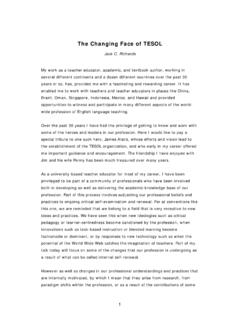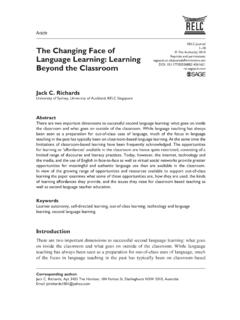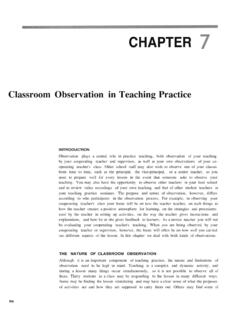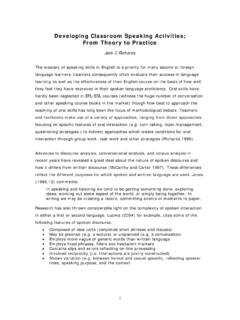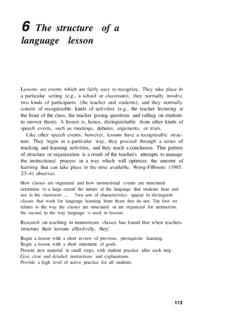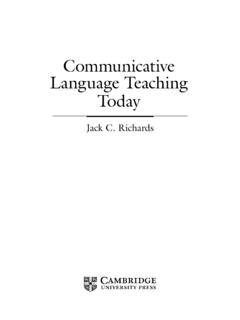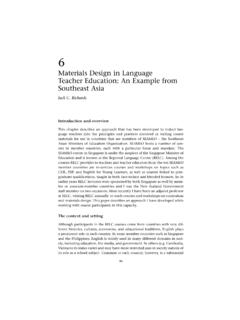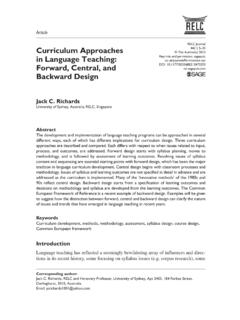Transcription of Teaching Listening and Speaking: From Theory to Practice
1 1 Teaching Listening and speaking : From Theory to Practice Jack C. Richards Introduction Courses in Listening and speaking skills have a prominent place in language programs around the world today. Ever-growing needs for fluency in English around the world as a consequence of the role of English as the world s international language have given priority to finding more effective ways to teach English and it is therefore timely to review what our current assumptions and practices are concerning the Teaching of these crucial language skills. Our understanding of the nature of Listening and speaking have undergone considerable changes in recent years however, and in this paper I will explore what some of those changes are and what their implications are for classroom Teaching and materials design.
2 The Teaching of Listening has attracted a greater level of interest in recent years than it did in the past. University entrance exams, school leaving and other examinations now often include a Listening component, acknowledging that Listening skills are a core component of second language proficiency, and also reflecting the assumption that if Listening isn t tested, teachers won t teach it. Earlier views of Listening saw it as the mastery of discrete skills or microskills, such as recognizing reduced forms of words, recognizing cohesive devices in texts, and identifying key words in a text, and that these skills should form the focus of Teaching . Later views of Listening drew on the filed of cognitive psychology, which introduced the notions of bottom-up and top-down processing and to the role of prior knowledge and schema in comprehension.
3 Listening came to be seen as an interpretive process. At the same time the field of discourse analysis and conversational analysis revealed a great deal about the nature and organization of spoken discourse and lead to a realization that written texts read aloud could not provide a suitable basis for developing the abilities needed to process real-time authentic discourse. Current views of Listening hence emphasize the role of the listener, who is seen an active participant in Listening , employing strategies to facilitate, monitor, and evaluate his or her Listening . 2 Listening has also been considered from a further perspective in recent years when it is examined in relation not only to comprehension, but also to language learning.
4 Since Listening can provide much of the input and data learners receive in language learning, an important question is, how can attention to the language the listener hears, facilitate second language learning? This raises the issue of the role noticing and conscious awareness of language form , and how noticing can be part of the process by which learners can incorporate new words forms, and structures into their developing communicative competence. This role for Listening will also be examined here. Approaches to the Teaching of speaking in EFL/ESL have been more strongly influenced by fads and fashions than the Teaching of Listening . speaking in traditional methodologies usually meant repeating after the teacher, memorizing a dialog, or responding to drills, reflecting the sentence-based view of proficiency prevailing in the audiolingual and other drill-based or repetition-based methodologies of the 1970s.
5 The emergence of communicative language Teaching in the 1980s lead to changed views of syllabuses and methodology, which are continuing to shape approaches to Teaching speaking skills today. grammar -based syllabuses were replaced by communicative syllabuses built around notion, functions, skills, tasks or other non-grammatical units of organization. Fluency became a goal for speaking courses and this could be developed through the use of information-gap and other tasks that required learners to attempt real communication despite limited proficiency in English. In so doing they would develop communication strategies and engage in negotiation of meaning, both of which were considered essential to the development of oral skills.
6 The notion of English as an international language has also prompted a revision of the notion of communicative competence to include the notion of intercultural competence. This shifts the focus to learning how to communicate in cross-cultural settings, where native-speaker norms of communication may not be a priority. At the same time it is now accepted that models for oral interaction in classroom materials cannot be simply based on the intuitions of textbook writers but should be informed by the findings of conversational analysis and the analysis of real speech. 3 Approaches to the Teaching of Listening and speaking will be explored here in the light of the kinds of issues discussed above.
7 My goal is to examine what applied linguistics research and Theory says about the nature of Listening and speaking skills, and then to explore what the implications are for classroom Teaching . We will begin with examining the Teaching of Listening 1: The Teaching of Listening I wish to consider Listening from two different perspectives, which I refer to as Listening as comprehension, and the second, Listening as acquisition. Listening As Comprehension Listening as comprehension is the traditional way of thinking about the nature of Listening . Indeed, in most methodology manuals Listening , and Listening comprehension are synonymous. This view of Listening is based on the assumption that the main function of Listening in second language learning is to facilitate understanding of spoken discourse.
8 We will examine this view of Listening in some detail before considering a complementary view of Listening Listening as acquisition. This latter view of Listening considers how Listening can provide input which triggers the further development of second language proficiency. Characteristics of spoken discourse In order to understand the nature of Listening processes, we need to consider some of the characteristics of spoken discourse and the special problems it poses for listeners. Spoken discourse has very different characteristics from written discourse and these differences can add a number of dimensions to our understanding of how we process speech. For example spoken discourse is usually instantaneous.
9 The listener must process it on-line and there is often no chance to listen to it again. Spoken discourse also often strikes the second language listener as being very fast, although speech rates vary considerably. Radio monologs may contain 160 words per minute, while conversation can consist of up to 220 words per minute. The impression of faster or slower speech generally results from the amount of intra clausal pausing that speakers make use of. Unlike written discourse, spoken discourse is usually unplanned and often reflects the processes of construction such as hesitations, reduced forms, fillers, and repeats. Spoken discourse has also been described as having a linear 4 structure, compared to a hierarchical structure for written discourse.
10 Whereas the unit of organization of written discourse is the sentence, spoken language is usually delivered one clause at a time and longer utterances in conversation generally consist of several clauses co-ordinated. Most of the clauses used are simple conjuncts or adjuncts. Spoken texts too are often context dependent and personal, often assuming shared background knowledge. Lastly, spoke texts may be spoken with many different accents, from standard to non-standard, to regional, non-native, and so on. Understanding spoken discourse: bottom-up and top-down processing Two different kinds of processes are involved in understanding spoken discourse. These are often referred to as bottom-up and top-down processing.
